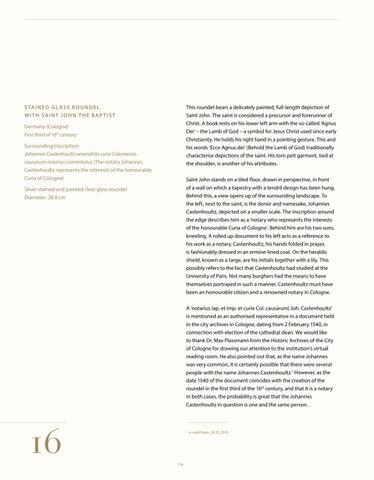S TA I N E D G L A S S R O U N D E L WITH SAINT JOHN THE BAPTIST
This roundel bears a delicately painted, full-length depiction of Saint John. The saint is considered a precursor and forerunner of Christ. A book rests on his lower left arm with the so-called ‘Agnus Dei’ – the Lamb of God – a symbol for Jesus Christ used since early Christianity. He holds his right hand in a pointing gesture. This and his words ‘Ecce Agnus dei’ (Behold the Lamb of God) traditionally characterise depictions of the saint. His torn pelt garment, tied at the shoulder, is another of his attributes.
Germany (Cologne) First third of 16th century Surrounding inscription: Johannes Castenhoultz venerabilis curie Coloniensis causarum notarius commitatus (The notary Johannes Castenhoultz represents the interests of the honourable Curia of Cologne)
Saint John stands on a tiled floor, drawn in perspective, in front of a wall on which a tapestry with a tendril design has been hung. Behind this, a view opens up of the surrounding landscape. To the left, next to the saint, is the donor and namesake, Johannes Castenhoultz, depicted on a smaller scale. The inscription around the edge describes him as a ‘notary who represents the interests of the honourable Curia of Cologne’. Behind him are his two sons, kneeling. A rolled up document to his left acts as a reference to his work as a notary. Castenhoultz, his hands folded in prayer, is fashionably dressed in an ermine-lined coat. On the heraldic shield, known as a targe, are his initials together with a lily. This possibly refers to the fact that Castenhoultz had studied at the University of Paris. Not many burghers had the means to have themselves portrayed in such a manner. Castenhoultz must have been an honourable citizen and a renowned notary in Cologne.
Silver stained and painted clear glass roundel Diameter: 28.8 cm
A ‘notarius (ap. et imp. et curie Col. causarum) Joh. Castenhoultz’ is mentioned as an authorised representative in a document held in the city archives in Cologne, dating from 2 February 1540, in connection with election of the cathedral dean. We would like to thank Dr. Max Plassmann from the Historic Archives of the City of Cologne for drawing our attention to the institution’s virtual reading room. He also pointed out that, as the name Johannes was very common, it is certainly possible that there were several people with the name Johannes Castenhoultz.1 However, as the date 1540 of the document coincides with the creation of the roundel in the first third of the 16th century, and that it is a notary in both cases, the probability is great that the Johannes Castenhoultz in question is one and the same person.
16
1
116
e-mail from, 24.01.2019

























